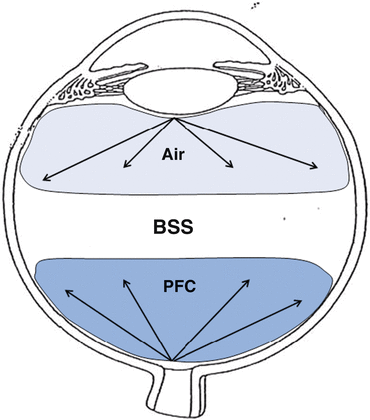and Mitrofanis Pavlidis2
(1)
Department of Ophthalmology, Uppsala University Hospital, Uppsala, Sweden
(2)
Augencentrum Köln, Cologne, Germany
5.1 Basics of Intraoperative Tamponade
Intraoperative tamponades have several indications. A fluid/air (fluid against air) exchange may be necessary to stain peripheral located PVR membranes. A fluid/air exchange removes the subretinal fluid in detachment surgery. Further, an air tamponade is a test for a successful detachment surgery. A PFCL (heavy liquid) tamponade is important in detachment surgery to attach the retina.
Question
Which intraoperative tamponades work opposite ways?
Answer
Air and PFCL. See Fig. 5.1.


Fig. 5.1
Opposite mechanisms of action of PFCL and air in a BSS-filled eye. Air fills the globe anteroposteriorly. PFC fills the globe posteroanteriorly
5.1.1 Air < = > PFCL
In the supine position, air exerts the most pressure on the anterior retina (ora serrata) and less on the posterior retina (Fig. 5.1). Because air is lighter than water or PFCL, the eye will be filled with air from the ora serrata and then down to the optic disc. To fill the eye completely with air, the surgeon must aspirate the liquid behind the air bubble with a flute needle. This is most easily done by holding the flute needle just above the optic disc until the liquid is completely removed.
Stay updated, free articles. Join our Telegram channel

Full access? Get Clinical Tree


